

Compact Muon Solenoid
LHC, CERN
| CMS-PAS-SMP-21-002 | ||
| Measurement of the Drell-Yan forward-backward asymmetry at high dilepton masses in proton-proton collisions at √s= 13 TeV | ||
| CMS Collaboration | ||
| October 2021 | ||
| Abstract: A measurement of the forward-backward asymmetry of oppositely charged lepton pairs (dielectron and dimuon) produced by the Drell-Yan process in proton-proton collisions is presented. The data sample corresponds to an integrated luminosity of 138 fb−1 collected with the CMS detector at the center-of-mass energy of 13 TeV. The asymmetry is measured for lepton pair masses larger than 170 GeV and compared with standard model predictions. No statistically significant deviations from standard model predictions are observed and the measurements are then used to set limits on the presence of additional gauge bosons. | ||
|
Links:
CDS record (PDF) ;
CADI line (restricted) ;
These preliminary results are superseded in this paper, Submitted to JHEP. The superseded preliminary plots can be found here. |
||
| Figures | |
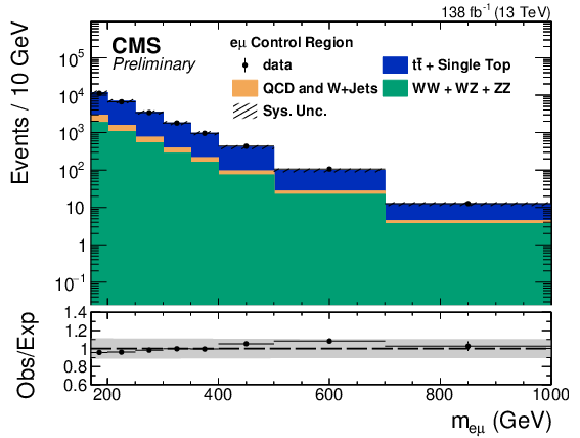
png pdf |
Figure 1:
The invariant mass distribution of eμ events observed in data (black dots with statistical uncertainties) and expected backgrounds (stacked histograms). The lower panel shows the ratio of the data to the expectation. The gray band represents the total uncertainty on the predicted yield. |
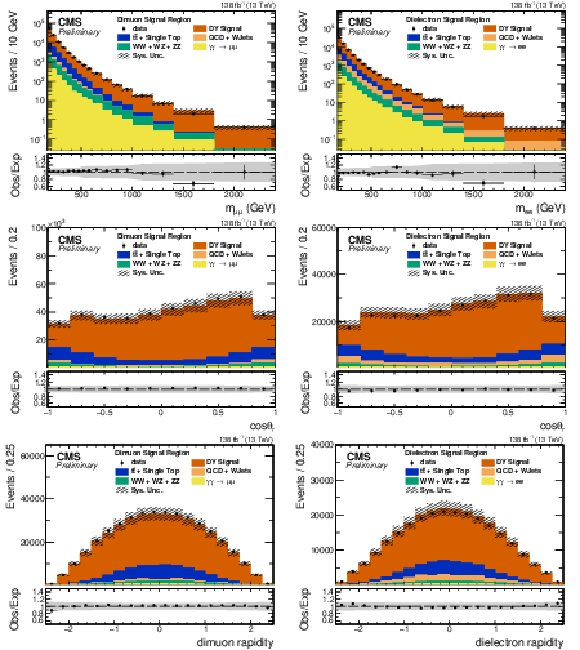
png pdf |
Figure 2:
A comparison of the data and expected signal and background distributions in m (top row), cosθr (middle row) and dilepton rapidity (bottom row). The left column shows the μμ channel and the right column the ee channel. The black points with error bars represent the data and their statistical uncertainties, whereas the combined signal and background expectation is shown as stacked histograms. The lower panel shows the ratio of the data to the expectation. The gray band represents the total uncertainty on the predicted yield. |
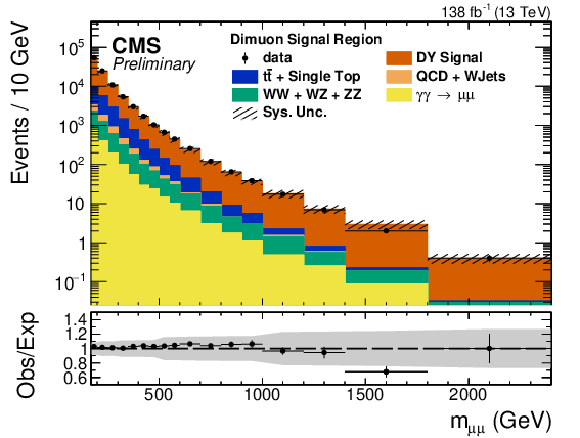
png pdf |
Figure 2-a:
A comparison of the data and expected signal and background distributions in m (top row), cosθr (middle row) and dilepton rapidity (bottom row). The left column shows the μμ channel and the right column the ee channel. The black points with error bars represent the data and their statistical uncertainties, whereas the combined signal and background expectation is shown as stacked histograms. The lower panel shows the ratio of the data to the expectation. The gray band represents the total uncertainty on the predicted yield. |

png pdf |
Figure 2-b:
A comparison of the data and expected signal and background distributions in m (top row), cosθr (middle row) and dilepton rapidity (bottom row). The left column shows the μμ channel and the right column the ee channel. The black points with error bars represent the data and their statistical uncertainties, whereas the combined signal and background expectation is shown as stacked histograms. The lower panel shows the ratio of the data to the expectation. The gray band represents the total uncertainty on the predicted yield. |
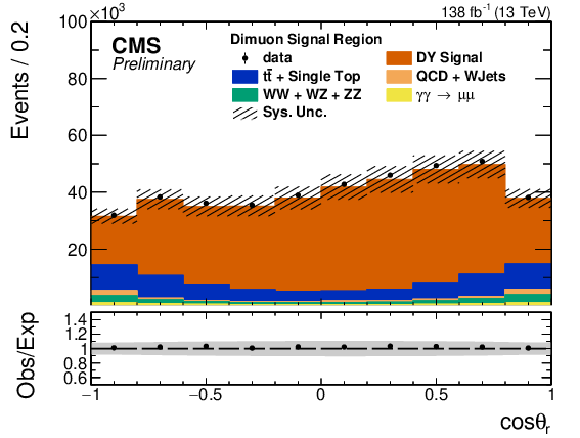
png pdf |
Figure 2-c:
A comparison of the data and expected signal and background distributions in m (top row), cosθr (middle row) and dilepton rapidity (bottom row). The left column shows the μμ channel and the right column the ee channel. The black points with error bars represent the data and their statistical uncertainties, whereas the combined signal and background expectation is shown as stacked histograms. The lower panel shows the ratio of the data to the expectation. The gray band represents the total uncertainty on the predicted yield. |
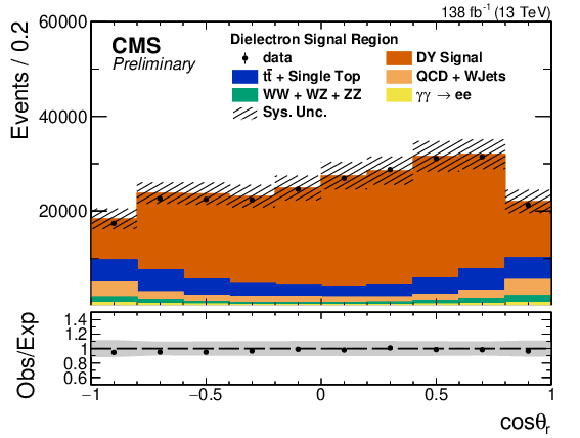
png pdf |
Figure 2-d:
A comparison of the data and expected signal and background distributions in m (top row), cosθr (middle row) and dilepton rapidity (bottom row). The left column shows the μμ channel and the right column the ee channel. The black points with error bars represent the data and their statistical uncertainties, whereas the combined signal and background expectation is shown as stacked histograms. The lower panel shows the ratio of the data to the expectation. The gray band represents the total uncertainty on the predicted yield. |

png pdf |
Figure 2-e:
A comparison of the data and expected signal and background distributions in m (top row), cosθr (middle row) and dilepton rapidity (bottom row). The left column shows the μμ channel and the right column the ee channel. The black points with error bars represent the data and their statistical uncertainties, whereas the combined signal and background expectation is shown as stacked histograms. The lower panel shows the ratio of the data to the expectation. The gray band represents the total uncertainty on the predicted yield. |
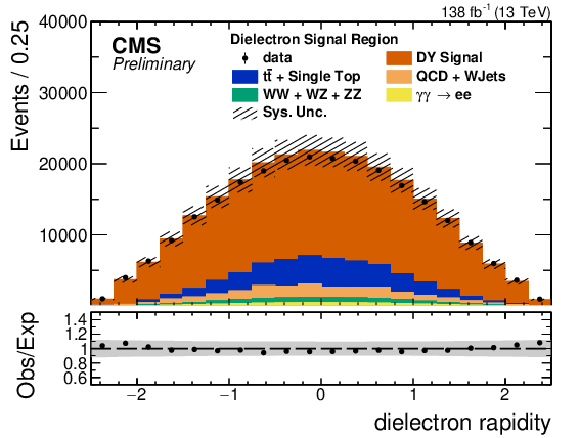
png pdf |
Figure 2-f:
A comparison of the data and expected signal and background distributions in m (top row), cosθr (middle row) and dilepton rapidity (bottom row). The left column shows the μμ channel and the right column the ee channel. The black points with error bars represent the data and their statistical uncertainties, whereas the combined signal and background expectation is shown as stacked histograms. The lower panel shows the ratio of the data to the expectation. The gray band represents the total uncertainty on the predicted yield. |

png pdf |
Figure 3:
Measurement of the DY forward-backward asymmetry as a function the dilepton mass as compared to MC predictions. The green line is the predicted value for AFB from aMC@NLO and the shaded green region the uncertainty on the predicted value. The red, blue, and black points and error bars represent the dielectron, dimuon and combined measurements respectively. Errors bars on the measurements include statistical and systematic errors. |

png pdf |
Figure 4:
Measurement of the difference in forward-backward asymmetry between the dimuon and dielectron channels. The green line is drawn at zero, the predicted value for ΔAFB assuming lepton flavor universality. The black points and error bars represent the measurements of ΔAFB in different mass bins. The blue line and shaded light blue region represent the inclusive measurement of ΔAFB and corresponding uncertainty. The errors bars on the measurements and the shaded region include statistical and systematic errors. |

png pdf |
Figure 5:
Exclusion limits at 95% CL on the coupling κL for a Z' in the sequential standard model as a function of the Z' mass. The expected (observed) limit is shown by the dashed (solid) line. The inner and outer shaded areas around the expected limits show the 68% and 95% CL intervals, respectively. The dashed blue line shows κL= 1 which corresponds to a Z' with exactly the same couplings as the SM Z boson. |

png pdf |
Figure 6:
The postfit distributions in the mass bin 170-200 GeV. The left column is the μμ channel, and the right column the ee channel. The contribution of the ττ background is not visible on the scale of these plots and has been omitted. The 2D templates follow the binning defined in Section xxxxx but have been presented in one dimension, where the first eight bins correspond the eight cr bins of the first y bin, the second eight bins the second y bin, the next six bins the third y bin and the final six bins the last y bin. The bottom panel in each figure shows the ratio between the number of events observed in data and the best fit value. The gray shaded region shows the total uncertainty on the best fit result and vertical error bars represent statistical uncertainties in the data. |

png pdf |
Figure 6-a:
The postfit distributions in the mass bin 170-200 GeV. The left column is the μμ channel, and the right column the ee channel. The contribution of the ττ background is not visible on the scale of these plots and has been omitted. The 2D templates follow the binning defined in Section xxxxx but have been presented in one dimension, where the first eight bins correspond the eight cr bins of the first y bin, the second eight bins the second y bin, the next six bins the third y bin and the final six bins the last y bin. The bottom panel in each figure shows the ratio between the number of events observed in data and the best fit value. The gray shaded region shows the total uncertainty on the best fit result and vertical error bars represent statistical uncertainties in the data. |
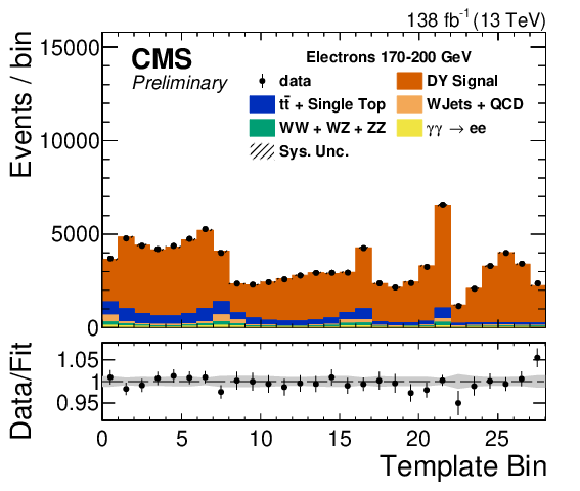
png pdf |
Figure 6-b:
The postfit distributions in the mass bin 170-200 GeV. The left column is the μμ channel, and the right column the ee channel. The contribution of the ττ background is not visible on the scale of these plots and has been omitted. The 2D templates follow the binning defined in Section xxxxx but have been presented in one dimension, where the first eight bins correspond the eight cr bins of the first y bin, the second eight bins the second y bin, the next six bins the third y bin and the final six bins the last y bin. The bottom panel in each figure shows the ratio between the number of events observed in data and the best fit value. The gray shaded region shows the total uncertainty on the best fit result and vertical error bars represent statistical uncertainties in the data. |
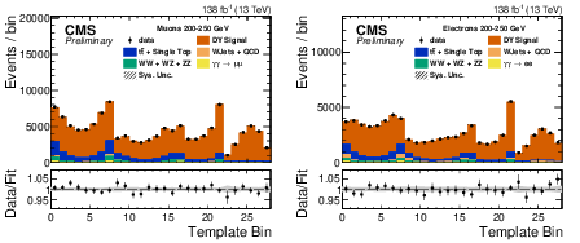
png pdf |
Figure 7:
The postfit distributions in the mass bin 200-250 GeV. The left column is the μμ channel, and the right column the ee channel. The contribution of the ττ background is not visible on the scale of these plots and has been omitted. The 2D templates follow the binning defined in Section xxxxx but have been presented in one dimension, where the first eight bins correspond the eight cr bins of the first y bin, the second eight bins the second y bin, the next six bins the third y bin and the final six bins the last y bin. The bottom panel in each figure shows the ratio between the number of events observed in data and the best fit value. The gray shaded region shows the total uncertainty on the best fit result and vertical error bars represent statistical uncertainties in the data. |
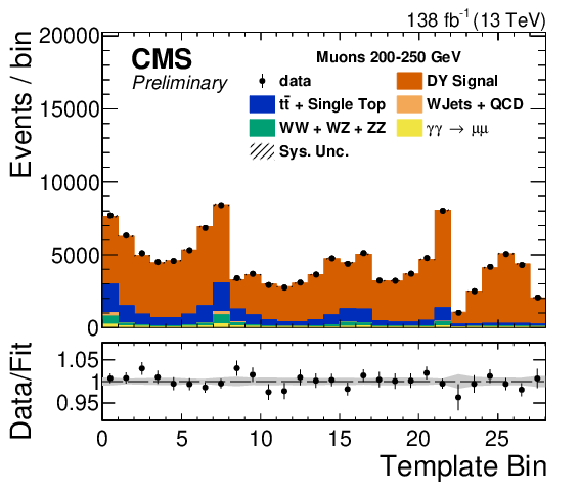
png pdf |
Figure 7-a:
The postfit distributions in the mass bin 200-250 GeV. The left column is the μμ channel, and the right column the ee channel. The contribution of the ττ background is not visible on the scale of these plots and has been omitted. The 2D templates follow the binning defined in Section xxxxx but have been presented in one dimension, where the first eight bins correspond the eight cr bins of the first y bin, the second eight bins the second y bin, the next six bins the third y bin and the final six bins the last y bin. The bottom panel in each figure shows the ratio between the number of events observed in data and the best fit value. The gray shaded region shows the total uncertainty on the best fit result and vertical error bars represent statistical uncertainties in the data. |
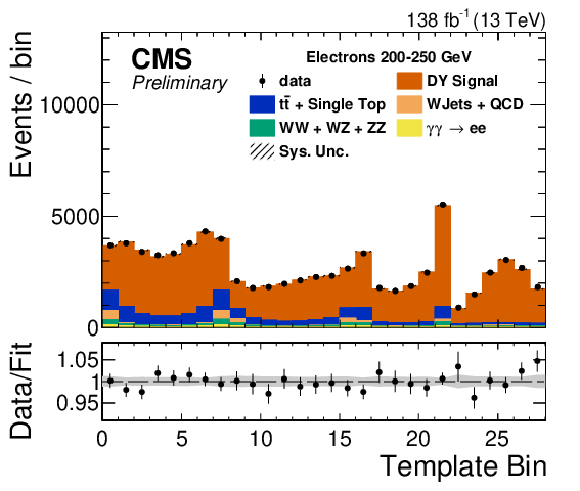
png pdf |
Figure 7-b:
The postfit distributions in the mass bin 200-250 GeV. The left column is the μμ channel, and the right column the ee channel. The contribution of the ττ background is not visible on the scale of these plots and has been omitted. The 2D templates follow the binning defined in Section xxxxx but have been presented in one dimension, where the first eight bins correspond the eight cr bins of the first y bin, the second eight bins the second y bin, the next six bins the third y bin and the final six bins the last y bin. The bottom panel in each figure shows the ratio between the number of events observed in data and the best fit value. The gray shaded region shows the total uncertainty on the best fit result and vertical error bars represent statistical uncertainties in the data. |

png pdf |
Figure 8:
The postfit distributions in the mass bin 250-320 GeV. The left column is the μμ channel, and the right column the ee channel. The contribution of the ττ background is not visible on the scale of these plots and has been omitted. The 2D templates follow the binning defined in Section xxxxx but have been presented in one dimension, where the first eight bins correspond the eight cr bins of the first y bin, the second eight bins the second y bin, the next six bins the third y bin and the final six bins the last y bin. The bottom panel in each figure shows the ratio between the number of events observed in data and the best fit value. The gray shaded region shows the total uncertainty on the best fit result and vertical error bars represent statistical uncertainties in the data. |

png pdf |
Figure 8-a:
The postfit distributions in the mass bin 250-320 GeV. The left column is the μμ channel, and the right column the ee channel. The contribution of the ττ background is not visible on the scale of these plots and has been omitted. The 2D templates follow the binning defined in Section xxxxx but have been presented in one dimension, where the first eight bins correspond the eight cr bins of the first y bin, the second eight bins the second y bin, the next six bins the third y bin and the final six bins the last y bin. The bottom panel in each figure shows the ratio between the number of events observed in data and the best fit value. The gray shaded region shows the total uncertainty on the best fit result and vertical error bars represent statistical uncertainties in the data. |
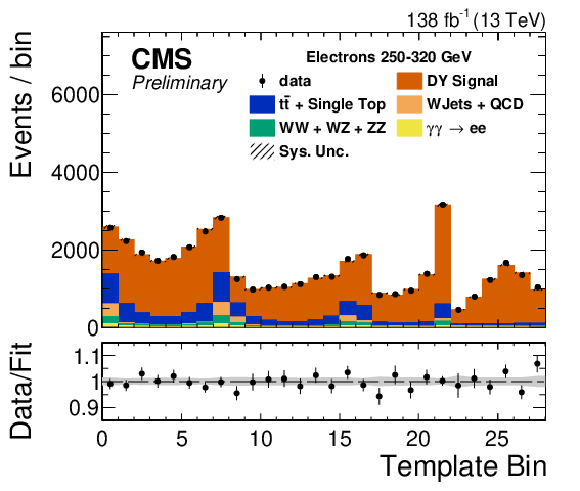
png pdf |
Figure 8-b:
The postfit distributions in the mass bin 250-320 GeV. The left column is the μμ channel, and the right column the ee channel. The contribution of the ττ background is not visible on the scale of these plots and has been omitted. The 2D templates follow the binning defined in Section xxxxx but have been presented in one dimension, where the first eight bins correspond the eight cr bins of the first y bin, the second eight bins the second y bin, the next six bins the third y bin and the final six bins the last y bin. The bottom panel in each figure shows the ratio between the number of events observed in data and the best fit value. The gray shaded region shows the total uncertainty on the best fit result and vertical error bars represent statistical uncertainties in the data. |

png pdf |
Figure 9:
The postfit distributions in the mass bin 320-510 GeV. The left column is the μμ channel, and the right column the ee channel. The contribution of the ττ background is not visible on the scale of these plots and has been omitted. The 2D templates follow the binning defined in Section xxxxx but have been presented in one dimension, where the first eight bins correspond the eight cr bins of the first y bin, the second eight bins the second y bin, the next six bins the third y bin and the final six bins the last y bin. The bottom panel in each figure shows the ratio between the number of events observed in data and the best fit value. The gray shaded region shows the total uncertainty on the best fit result and vertical error bars represent statistical uncertainties in the data. |

png pdf |
Figure 9-a:
The postfit distributions in the mass bin 320-510 GeV. The left column is the μμ channel, and the right column the ee channel. The contribution of the ττ background is not visible on the scale of these plots and has been omitted. The 2D templates follow the binning defined in Section xxxxx but have been presented in one dimension, where the first eight bins correspond the eight cr bins of the first y bin, the second eight bins the second y bin, the next six bins the third y bin and the final six bins the last y bin. The bottom panel in each figure shows the ratio between the number of events observed in data and the best fit value. The gray shaded region shows the total uncertainty on the best fit result and vertical error bars represent statistical uncertainties in the data. |
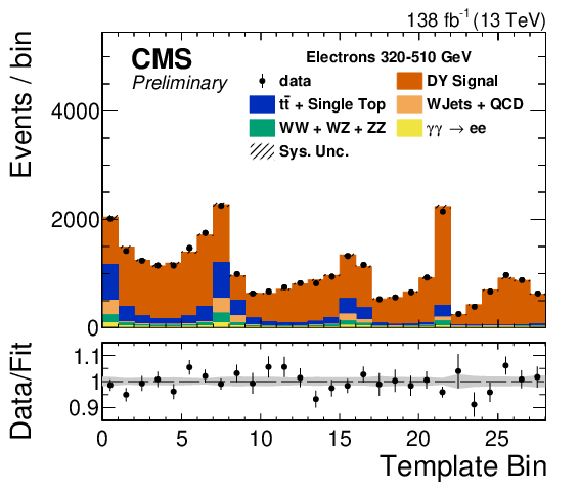
png pdf |
Figure 9-b:
The postfit distributions in the mass bin 320-510 GeV. The left column is the μμ channel, and the right column the ee channel. The contribution of the ττ background is not visible on the scale of these plots and has been omitted. The 2D templates follow the binning defined in Section xxxxx but have been presented in one dimension, where the first eight bins correspond the eight cr bins of the first y bin, the second eight bins the second y bin, the next six bins the third y bin and the final six bins the last y bin. The bottom panel in each figure shows the ratio between the number of events observed in data and the best fit value. The gray shaded region shows the total uncertainty on the best fit result and vertical error bars represent statistical uncertainties in the data. |

png pdf |
Figure 10:
The postfit distributions in the mass bin 510-700 GeV. The left column is the μμ channel, and the right column the ee channel. The contribution of the ττ background is not visible on the scale of these plots and has been omitted. The 2D templates follow the binning defined in Section xxxxx but have been presented in one dimension, where the first eight bins correspond the eight cr bins of the first y bin, the second eight bins the second y bin, the next six bins the third y bin and the final six bins the last y bin. The bottom panel in each figure shows the ratio between the number of events observed in data and the best fit value. The gray shaded region shows the total uncertainty on the best fit result and vertical error bars represent statistical uncertainties in the data. |
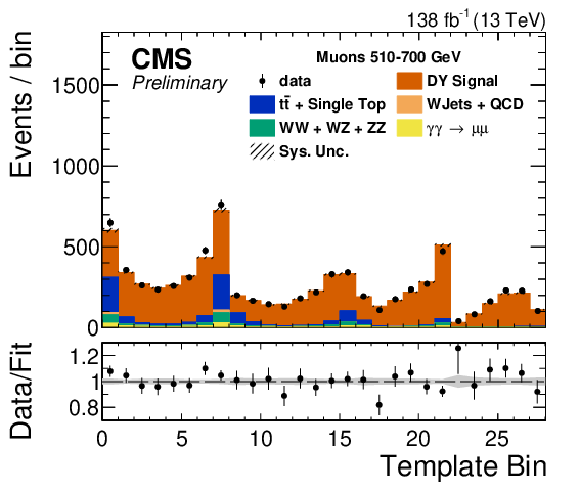
png pdf |
Figure 10-a:
The postfit distributions in the mass bin 510-700 GeV. The left column is the μμ channel, and the right column the ee channel. The contribution of the ττ background is not visible on the scale of these plots and has been omitted. The 2D templates follow the binning defined in Section xxxxx but have been presented in one dimension, where the first eight bins correspond the eight cr bins of the first y bin, the second eight bins the second y bin, the next six bins the third y bin and the final six bins the last y bin. The bottom panel in each figure shows the ratio between the number of events observed in data and the best fit value. The gray shaded region shows the total uncertainty on the best fit result and vertical error bars represent statistical uncertainties in the data. |

png pdf |
Figure 10-b:
The postfit distributions in the mass bin 510-700 GeV. The left column is the μμ channel, and the right column the ee channel. The contribution of the ττ background is not visible on the scale of these plots and has been omitted. The 2D templates follow the binning defined in Section xxxxx but have been presented in one dimension, where the first eight bins correspond the eight cr bins of the first y bin, the second eight bins the second y bin, the next six bins the third y bin and the final six bins the last y bin. The bottom panel in each figure shows the ratio between the number of events observed in data and the best fit value. The gray shaded region shows the total uncertainty on the best fit result and vertical error bars represent statistical uncertainties in the data. |
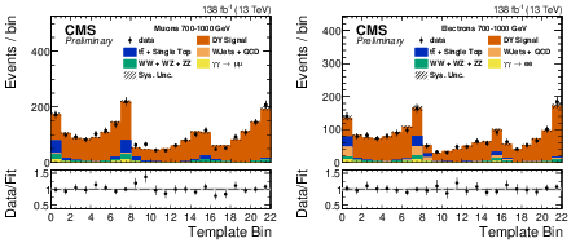
png pdf |
Figure 11:
The postfit distributions in the mass bin 700-1000 GeV. The left column is the μμ channel, and the right column the ee channel. The contribution of the ττ background is not visible on the scale of these plots and has been omitted. The 2D templates follow the binning defined in Section xxxxx but have been presented in one dimension, where the first eight bins correspond the eight cr bins of the first y bin, the second eight bins the second y bin, the next six bins the third y bin and the final six bins the last y bin. The bottom panel in each figure shows the ratio between the number of events observed in data and the best fit value. The gray shaded region shows the total uncertainty on the best fit result and vertical error bars represent statistical uncertainties in the data. |
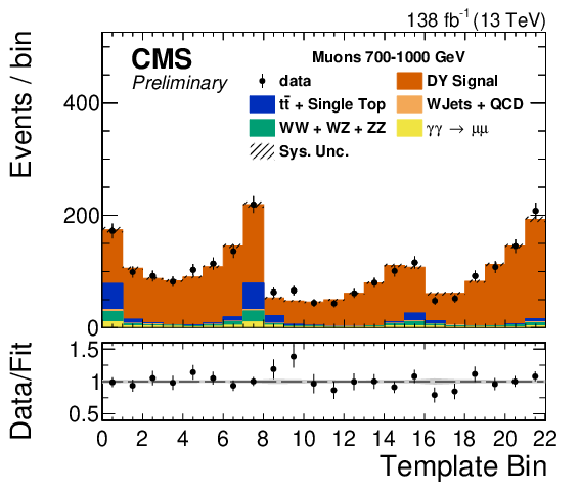
png pdf |
Figure 11-a:
The postfit distributions in the mass bin 700-1000 GeV. The left column is the μμ channel, and the right column the ee channel. The contribution of the ττ background is not visible on the scale of these plots and has been omitted. The 2D templates follow the binning defined in Section xxxxx but have been presented in one dimension, where the first eight bins correspond the eight cr bins of the first y bin, the second eight bins the second y bin, the next six bins the third y bin and the final six bins the last y bin. The bottom panel in each figure shows the ratio between the number of events observed in data and the best fit value. The gray shaded region shows the total uncertainty on the best fit result and vertical error bars represent statistical uncertainties in the data. |

png pdf |
Figure 11-b:
The postfit distributions in the mass bin 700-1000 GeV. The left column is the μμ channel, and the right column the ee channel. The contribution of the ττ background is not visible on the scale of these plots and has been omitted. The 2D templates follow the binning defined in Section xxxxx but have been presented in one dimension, where the first eight bins correspond the eight cr bins of the first y bin, the second eight bins the second y bin, the next six bins the third y bin and the final six bins the last y bin. The bottom panel in each figure shows the ratio between the number of events observed in data and the best fit value. The gray shaded region shows the total uncertainty on the best fit result and vertical error bars represent statistical uncertainties in the data. |
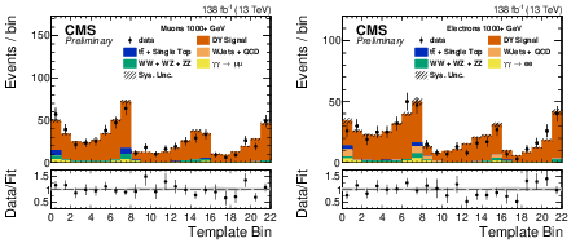
png pdf |
Figure 12:
The postfit distributions in the mass bin ≥ 1000 GeV. The left column is the μμ channel, and the right column the ee channel. The contribution of the ττ background is not visible on the scale of these plots and has been omitted. The 2D templates follow the binning defined in Section xxxxx but have been presented in one dimension, where the first eight bins correspond the eight cr bins of the first y bin, the second eight bins the second y bin, the next six bins the third y bin and the final six bins the last y bin. The bottom panel in each figure shows the ratio between the number of events observed in data and the best fit value. The gray shaded region shows the total uncertainty on the best fit result and vertical error bars represent statistical uncertainties in the data. |

png pdf |
Figure 12-a:
The postfit distributions in the mass bin ≥ 1000 GeV. The left column is the μμ channel, and the right column the ee channel. The contribution of the ττ background is not visible on the scale of these plots and has been omitted. The 2D templates follow the binning defined in Section xxxxx but have been presented in one dimension, where the first eight bins correspond the eight cr bins of the first y bin, the second eight bins the second y bin, the next six bins the third y bin and the final six bins the last y bin. The bottom panel in each figure shows the ratio between the number of events observed in data and the best fit value. The gray shaded region shows the total uncertainty on the best fit result and vertical error bars represent statistical uncertainties in the data. |
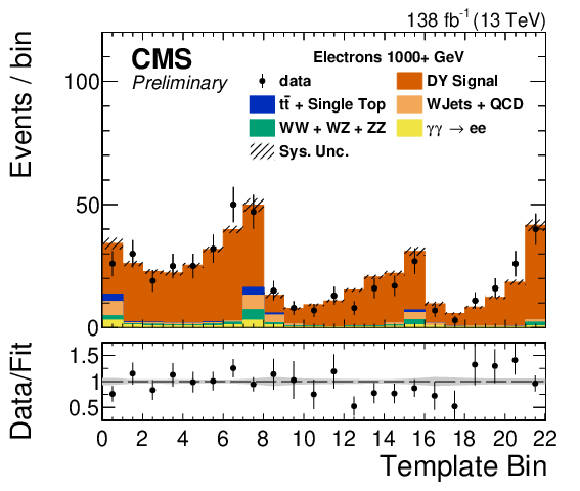
png pdf |
Figure 12-b:
The postfit distributions in the mass bin ≥ 1000 GeV. The left column is the μμ channel, and the right column the ee channel. The contribution of the ττ background is not visible on the scale of these plots and has been omitted. The 2D templates follow the binning defined in Section xxxxx but have been presented in one dimension, where the first eight bins correspond the eight cr bins of the first y bin, the second eight bins the second y bin, the next six bins the third y bin and the final six bins the last y bin. The bottom panel in each figure shows the ratio between the number of events observed in data and the best fit value. The gray shaded region shows the total uncertainty on the best fit result and vertical error bars represent statistical uncertainties in the data. |
| Tables | |

png pdf |
Table 1:
Results for the measurement of AFB from the maximum likelihood fit to data in different mass bins in the different channels. The first uncertainty listed with each measurement corresponds to the statistical uncertainty and the second the systematic uncertainty. |

png pdf |
Table 2:
Results for the measurement of A0 from the maximum likelihood fit to data in different mass bins in the different channels. The first uncertainty listed with each measurement corresponds to the statistical uncertainty and the second the systematic uncertainty. To help in the interpretation of these results, we also list the average dilepton pT of the data events in each mass bin. |

png pdf |
Table 3:
Results for the measurement of ΔAFB and ΔA0 from the maximum likelihood fit to data in different mass bins as well as an inclusive measurement across all mass bins. The first uncertainty listed with each measurement corresponds to the statistical uncertainty and the second the systematic uncertainty. |

png pdf |
Table 4:
The fraction of photon-induced background as compared to the total amount of DY signal plus photon-induced events (NγγNγγ+NDY) in the different mass bins. These numbers are averaged across the different years and channels. |
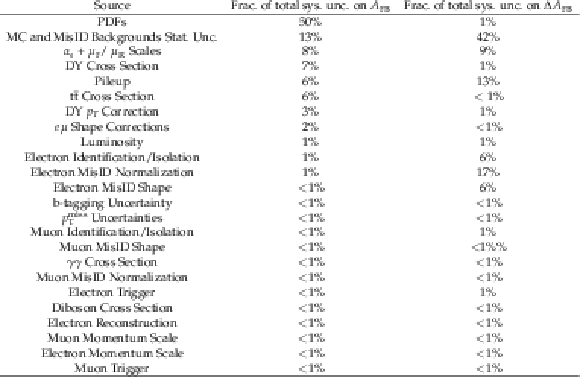
png pdf |
Table 5:
A comparison of the magnitude of the different sources of systematic uncertainty for the measurement AFB when combining the electron and muon channels and for the measurement of ΔAFB. Results for the 170-200 GeV mass bin are shown because that is the mass bin in which the systematic uncertainty has the largest contribution to the total uncertainty; the results for other mass bins are similar. The contributions from different sources of systematic uncertainty are evaluated by running the fit while freezing different groups of nuisances and taking the quadrature difference between the resulting uncertainty and the full uncertainty. Results are reported as a fraction of the overall systematic uncertainty for the measurement of AFB and ΔAFB respectively. |
| Summary |
| The CMS detector at the LHC has been used to measure the DY forward-backward asymmetry, AFB, for muon and electron pairs with invariant mass above 170 GeV. The measurement is performed using 138 fb−1 of proton-proton collision data at √s= 13 TeV collected in Run 2 using a new template fitting approach. The measurements show good agreement with the standard model and limits are set on the existence additional gauge bosons. For a Z' boson in the canonical Sequential standard model, a lower limit on its mass is set at mZ′> 4.4 TeV. |
| References | ||||
| 1 | D. London and J. Rosner | Extra gauge bosons in E6 | PRD 34 (1986) 1530 | |
| 2 | J. Rosner | Off-peak lepton asymmetries from new Z's | PRD 35 (1987) 2244 | |
| 3 | J. Rosner | Forward-backward asymmetries in hadronically produced lepton pairs | PRD 54 (1996) 1078 | |
| 4 | A. Bodek and U. Baur | Implications of a 300-500 GeV /c2 Z' boson on pˉp collider data at √s= 1.8 TeV | EPJC 21 (2001) 607 | hep-ph/0102160 |
| 5 | T. G. Rizzo | Z' Phenomenology and the LHC | in Theoretical Advanced Study Institute in Elementary Particle Physics: Exploring New Frontiers Using Colliders and Neutrinos 10, 2006 SLAC-PUB-12129 | hep-ph/0610104 |
| 6 | E. Accomando et al. | Forward-backward asymmetry as a discovery tool for Z' bosons at the LHC | JHEP 01 (2016) 127 | 1503.02672 |
| 7 | E. Accomando et al. | Production of Z'-boson resonances with large width at the LHC | PLB 803 (2020) 135293 | 1910.13759 |
| 8 | E. Eichten, K. D. Lane, and M. E. Peskin | New tests for quark and lepton substructure | PRL 50 (1983) 811 | |
| 9 | J. L. Hewett | Indirect collider signals for extra dimensions | PRL 82 (1999) 4765 | hep-ph/9811356 |
| 10 | C. Gross, O. Lebedev, and J. M. No | Drell-Yan constraints on new electroweak states: LHC as a pp→l+l− precision machine | MPLA 32 (2017) 1750094 | 1602.03877 |
| 11 | R. M. Capdevilla, A. Delgado, A. Martin, and N. Raj | Characterizing dark matter at the LHC in Drell-Yan events | PRD 97 (2018) 035016 | 1709.00439 |
| 12 | N. Raj | Anticipating nonresonant new physics in dilepton angular spectra at the LHC | PRD 95 (2017) 015011 | 1610.03795 |
| 13 | ATLAS Collaboration | Search for high-mass dilepton resonances using 139 fb−1 of pp collision data collected at √s= 13 TeV with the ATLAS detector | PLB 796 (2019) 68 | 1903.06248 |
| 14 | CMS Collaboration | Search for resonant and nonresonant new phenomena in high-mass dilepton final states at √s= 13 TeV | JHEP 07 (2021) 208 | CMS-EXO-19-019 2103.02708 |
| 15 | J. Collins and D. Soper | Angular distribution of dileptons in high-energy hadron collisions | PRD 16 (1977) 2219 | |
| 16 | CMS Collaboration | Forward-backward asymmetry of Drell-Yan lepton pairs in pp collisions at √s= 7 TeV | PLB 718 (2013) 752 | |
| 17 | CMS Collaboration | Forward-backward asymmetry of Drell-Yan lepton pairs in pp collisions at √s= 8 TeV | EPJC 76 (2016) 325 | |
| 18 | ATLAS Collaboration | Measurement of the forward-backward asymmetry of electron and muon pair-production in pp collisions at √s= 7 TeV with the ATLAS detector | JHEP 09 (2015) 049 | 1503.03709 |
| 19 | CMS Collaboration | Measurement of the weak mixing angle using the forward-backward asymmetry of Drell-Yan events in pp collisions at 8 TeV | EPJC 78 (2018) 701 | CMS-SMP-16-007 1806.00863 |
| 20 | ATLAS Collaboration | Measurement of the effective leptonic weak mixing angle using electron and muon pairs from Z-boson decay in the ATLAS experiment at √s= 8 TeV | ATLAS CONF Note, CERN, Geneva, Jul | |
| 21 | CMS Collaboration | The CMS experiment at the CERN LHC | JINST 3 (2008) S08004 | CMS-00-001 |
| 22 | CMS Collaboration | Performance of the cms level-1 trigger in proton-proton collisions at √s= 13 TeV | JINST 15 (2020) P10017 | CMS-TRG-17-001 2006.10165 |
| 23 | CMS Collaboration | The CMS trigger system | JINST 12 (2017) P01020 | CMS-TRG-12-001 1609.02366 |
| 24 | CMS Collaboration | Particle-flow reconstruction and global event description with the CMS detector | JINST 12 (2017) P10003 | CMS-PRF-14-001 1706.04965 |
| 25 | CMS Collaboration | Performance of the CMS muon detector and muon reconstruction with proton-proton collisions at √s= 13 TeV | JINST 13 (2018) P06015 | CMS-MUO-16-001 1804.04528 |
| 26 | CMS Collaboration | Electron and photon reconstruction and identification with the CMS experiment at the CERN LHC | JINST 16 (2021) P05014 | CMS-EGM-17-001 2012.06888 |
| 27 | M. Cacciari, G. P. Salam, and G. Soyez | The anti-kt jet clustering algorithm | JHEP 04 (2008) 063 | 0802.1189 |
| 28 | M. Cacciari, G. P. Salam, and G. Soyez | Fastjet user manual | EPJC 72 (2012) 1896 | 1111.6097 |
| 29 | CMS Collaboration | Jet energy scale and resolution in the CMS experiment in pp collisions at 8 TeV | JINST 12 (2017) P02014 | CMS-JME-13-004 1607.03663 |
| 30 | CMS Collaboration | Performance of missing transverse momentum reconstruction in proton-proton collisions at √s= 13 TeV using the CMS detector | JINST 14 (2019) P07004 | CMS-JME-17-001 1903.06078 |
| 31 | CMS Collaboration | Precision luminosity measurement in proton-proton collisions at √s= 13 TeV in 2015 and 2016 at CMS | EPJC 81 (2021) 800 | CMS-LUM-17-003 2104.01927 |
| 32 | CMS Collaboration | CMS luminosity measurement for the 2017 data-taking period at √s= 13 TeV | CMS-PAS-LUM-17-004 | CMS-PAS-LUM-17-004 |
| 33 | CMS Collaboration | CMS luminosity measurement for the 2018 data-taking period at √s= 13 TeV | CMS-PAS-LUM-18-002 | CMS-PAS-LUM-18-002 |
| 34 | J. Alwall et al. | The automated computation of tree-level and next-to-leading order differential cross sections, and their matching to parton shower simulations | JHEP 07 (2014) 079 | 1405.0301 |
| 35 | R. Frederix and S. Frixione | Merging meets matching in MC@NLO | JHEP 12 (2012) 061 | 1209.6215 |
| 36 | T. Sjostrand et al. | An introduction to PYTHIA 8.2 | CPC 191 (2015) 159 | 1410.3012 |
| 37 | CMS Collaboration | Event generator tunes obtained from underlying event and multiparton scattering measurements | EPJC 76 (2016) 155 | CMS-GEN-14-001 1512.00815 |
| 38 | CMS Collaboration | Extraction and validation of a new set of CMS PYTHIA8 tunes from underlying-event measurements | EPJC 80 (2020) 4 | CMS-GEN-17-001 1903.12179 |
| 39 | R. D. Ball et al. | A first unbiased global NLO determination of parton distributions and their uncertainties | NPB 838 (2010) 136 | 1002.4407 |
| 40 | NNPDF Collaboration | Parton distributions for the LHC Run II | JHEP 04 (2015) 040 | 1410.8849 |
| 41 | P. Nason | A new method for combining NLO QCD with shower Monte Carlo algorithms | JHEP 11 (2004) 040 | hep-ph/0409146 |
| 42 | S. Frixione, P. Nason, and C. Oleari | Matching NLO QCD computations with parton shower simulations: the POWHEG method | JHEP 11 (2007) 070 | 0709.2092 |
| 43 | S. Alioli, P. Nason, C. Oleari, and E. Re | A general framework for implementing NLO calculations in shower monte carlo programs: the POWHEG BOX | JHEP 06 (2010) 043 | 1002.2581 |
| 44 | S. Frixione, P. Nason, and G. Ridolfi | A positive-weight next-to-leading-order Monte Carlo for heavy flavour hadroproduction | JHEP 09 (2007) 126 | 0707.3088 |
| 45 | CMS Collaboration | Investigations of the impact of the parton shower tuning in Pythia 8 in the modelling of t¯t at √s= 8 and 13 TeV | CMS-PAS-TOP-16-021 | CMS-PAS-TOP-16-021 |
| 46 | J. A. M. Vermaseren | Two photon processes at very high-energies | NPB 229 (1983) 347 | |
| 47 | S. Baranov, O. Duenger, H. Shooshtari, and J. Vermaseren | LPAIR: A generator for lepton pair production | in Workshop on Physics at HERA, p. 1478 1991 | |
| 48 | A. Suri and D. R. Yennie | The space-time phenomenology of photon absorbtion and inelastic electron scattering | Annals Phys. 72 (1972) 243 | |
| 49 | J. M. Campbell, R. K. Ellis, and W. T. Giele | A multi-threaded version of MCFM | EPJC 75 (2015) 246 | 1503.06182 |
| 50 | T. Gehrmann et al. | W+W− Production at hadron colliders in next to next to leading order QCD | PRL 113 (2014) 212001 | 1408.5243 |
| 51 | M. Czakon and A. Mitov | Top++: A program for the calculation of the top-pair cross-section at hadron colliders | CPC 185 (2014) 2930 | 1112.5675 |
| 52 | S. Agostinelli et al. | Geant4--a simulation toolkit | NIM A 506 (2003) 250 | |
| 53 | CMS Collaboration | Performance of the reconstruction and identification of high-momentum muons in proton-proton collisions at √s= 13 TeV | JINST 15 (2020) P02027 | CMS-MUO-17-001 1912.03516 |
| 54 | CMS Collaboration | Identification of heavy-flavour jets with the CMS detector in pp collisions at 13 TeV | JINST 13 (2018) P05011 | CMS-BTV-16-002 1712.07158 |
| 55 | CMS Collaboration | Measurement of the differential Drell-Yan cross section in proton-proton collisions at √s= 13 TeV | JHEP 12 (2019) 059 | CMS-SMP-17-001 1812.10529 |
| 56 | CMS Collaboration | Search for physics beyond the standard model in dilepton mass spectra in proton-proton collisions at √s= 8 TeV | JHEP 04 (2015) 025 | CMS-EXO-12-061 1412.6302 |
| 57 | CMS Collaboration | Measurement of the top quark forward-backward production asymmetry and the anomalous chromoelectric and chromomagnetic moments in pp collisions at √s= 13 TeV | JHEP 06 (2020) 146 | CMS-TOP-15-018 1912.09540 |
| 58 | A. Bodek et al. | Extracting muon momentum scale corrections for hadron collider experiments | EPJC 72 (2012) 2194 | 1208.3710 |
| 59 | R. Gavin, Y. Li, F. Petriello, and S. Quackenbush | FEWZ 2.0: A code for hadronic Z production at next-to-next-to-leading order | CPC 182 (2011) 2388 | 1011.3540 |
| 60 | F. Cascioli et al. | ZZ production at hadron colliders in NNLO QCD | PLB 735 (2014) 311 | 1405.2219 |
| 61 | J. M. Campbell, R. K. Ellis, and C. Williams | Vector boson pair production at the LHC | JHEP 07 (2011) 018 | 1105.0020 |
| 62 | A. Manohar, P. Nason, G. P. Salam, and G. Zanderighi | How bright is the proton? A precise determination of the photon parton distribution function | PRL 117 (2016) 242002 | 1607.04266 |
| 63 | A. V. Manohar, P. Nason, G. P. Salam, and G. Zanderighi | The photon content of the proton | JHEP 12 (2017) 046 | 1708.01256 |
| 64 | J. S. Conway | Incorporating nuisance parameters in likelihoods for multisource spectra | in PHYSTAT 2011 3 | 1103.0354 |
| 65 | CMS Collaboration | Measurement of the inelastic proton-proton cross section at √s= 13 TeV | JHEP 07 (2018) 161 | CMS-FSQ-15-005 1802.02613 |
| 66 | G. Altarelli, B. Mele, and M. Ruiz-Altaba | Searching for new heavy vector bosons in pˉp colliders | Z. Phys. C 45 (1989) 109, . [Erratum: Z.Phys.C] | |
| 67 | B. Fuks and R. Ruiz | A comprehensive framework for studying W′ and Z′ bosons at hadron colliders with automated jet veto resummation | JHEP 05 (2017) 032 | 1701.05263 |

|
Compact Muon Solenoid LHC, CERN |

|

|

|

|

|

|